Treatment of immunological disorders using anti-dc30 antibodies
a technology of immunological disorders and antibodies, applied in the field of immunological disorders using anti-dc30 antibodies, can solve the problems of ineffective treatment of such disorders, inability to demonstrate the effectiveness of targeting cd30 by mab, and increased thymocyte depletion, so as to and enhance the cytotoxic or cytostatic effect of cd30 antibody
- Summary
- Abstract
- Description
- Claims
- Application Information
AI Technical Summary
Benefits of technology
Problems solved by technology
Method used
Image
Examples
example 1
6. EXAMPLE 1
Expression of CD30 on the Jurkat Human T Lymphocyte Cell Line
[0390] The Jurkat cell line is an acute T leukemia cell line that expresses the CD3 / T cell receptor (TCR) complex and other important accessory molecules involved in T cell functions. Sub-lines derived from the original Jurkat line have been applied extensively as model systems to elucidate signaling pathways mediated by a multitude of receptor systems, e.g., CD3 / T cell receptor (TCR). A number of signaling pathways in Jurkat T cells initiated upon the ligation of surface receptors have been demonstrated to take place in normal T lymphocytes subjected to antigenic challenge. Jurkat T cells were found to consistently express detectable levels of CD30 (FIG. 1), and therefore they may be a model system to examine the function of CD30 in activated lymphocytes.
example 2
7. EXAMPLE 2
Cross-Linking of CD30 on Jurkat T Cells by Anti-CD30 mAbs Inhibited DNA Synthesis
[0391] The effect of signaling through CD30 by anti-CD30 on the proliferation of Jurkat T cells was assessed by tritiated thymidine (3H-TdR) incorporation assays. Jurkat cells were treated with soluble anti-CD30 in graded doses or anti-CD30 cross-linked by a secondary cross-linking antibody (Ab). For secondary cross-linking of cAC10, the monoclonal antibody (mAb) was mixed with F(ab′)2 fragments of goat anti-human (GAM) IgG Fc (Jackson ImmunoResearch, West Groove, Pa.) in culture medium (RPMI-1640, 10% FBS, 2 mM L-glutamine, 1 mM sodium pyruvate, and 0.1 mM non-essential amino acids). For secondary cross-linking of murine anti-CD30 mAb (AC10 and HeFi-1), the mAbs were mixed with F(ab′)2 fragments of goat anti-mouse (GAM) IgG Fc (Jackson ImmunoResearch) in culture medium. Final ratios of 1:2.5, 1:5, and 1:10 between the primary mAbs and secondary cross-linking antibodies were used. Antibody ...
example 3
8. EXAMPLE 3
Cross-Linking of CD30 by Anti-CD30 mAbs Induced DNA Fragmentation (Apoptosis) in Jurkat T Cells
[0393] The relationship between cell cycle status and DNA replication in Jurkat cells treated with cross-linked anti-CD30 in Abs was further investigated. Four μg / ml of the anti-CD30 mAb AC10 or HeFi-1 were mixed with F(ab′)2 fragments of GAM IgG Fc (Jackson ImmunoResearch) at final ratios (weight:weight) of 1:4 in culture medium (RPMI-1640, 10% FBS, 2 mM L-glutamine, 1 mM sodium pyruvate, and 0.1 mM non-essential amino acids). The antibody cocktails were allowed to incubate at room temperature for 15 minutes. Serial 1:10 dilutions of these antibody cocktails in culture medium were then prepared. One ml of antibody cocktails was then mixed with 1 ml of Jurkat cell suspension containing 0.25×106 cells in 12-well TC plates.
[0394] After 24 or 48 hours of incubation, cells were harvested by centrifugation and resuspended in 2 ml of fresh medium equilibrated at 37° C. Bromodeoxyur...
PUM
| Property | Measurement | Unit |
|---|---|---|
| Electrical conductance | aaaaa | aaaaa |
| Cytotoxicity | aaaaa | aaaaa |
| Disorder | aaaaa | aaaaa |
Abstract
Description
Claims
Application Information
 Login to View More
Login to View More - R&D
- Intellectual Property
- Life Sciences
- Materials
- Tech Scout
- Unparalleled Data Quality
- Higher Quality Content
- 60% Fewer Hallucinations
Browse by: Latest US Patents, China's latest patents, Technical Efficacy Thesaurus, Application Domain, Technology Topic, Popular Technical Reports.
© 2025 PatSnap. All rights reserved.Legal|Privacy policy|Modern Slavery Act Transparency Statement|Sitemap|About US| Contact US: help@patsnap.com



